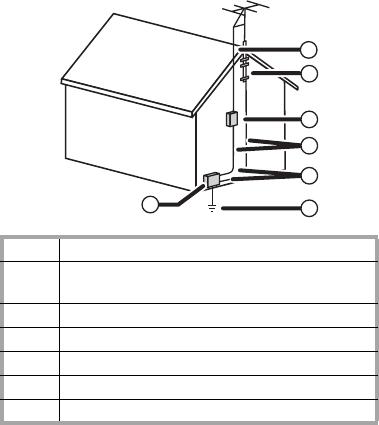
Important safety instructions
5
• If your TV does not operate normally by following the operating
instructions. Adjust only those controls that are covered by the
operating instructions because incorrect adjustment of other
controls may result in damage and will often require extensive
work by a qualified technician to restore your TV to its normal
operation.
• If your TV has been dropped or damaged in any way.
• When your TV exhibits a distinct change in performance.
Replacement parts
When replacement parts are required, make sure that the service
technician uses replacement parts specified by the manufacturer that
have the same characteristics as the original part. Unauthorized
substitutions may result in fire, electric shock, personal injury, or other
hazards.
Safety check
After completing any service or repair to this TV, ask the service
technician to perform routine safety checks to determine that your TV is
in correct operating condition.
Wall or ceiling mounting
When mounting this TV on a wall or ceiling, be sure to install the TV
according to the method recommended by the manufacturer. This is a
safety feature.
Power source
Operate your TV only from the type of power source indicated on the
marking label. If you are not sure of the type of power supplied to your
home, consult your TV dealer or local power company.
Lightning
For added protection for your TV’s receiver during a lightning storm, or
when it is left unattended and unused for long periods of time, unplug
it from the power outlet and disconnect the antenna or cable system.
This helps prevent damage to your TV from lightning and power line
surges.
Screen protection
Your TV’s screen is made of glass. Do not drop your TV or hit the glass
screen. If the screen breaks, be careful of broken glass.
Non-active pixels
The LCD panel contains almost 3 million thin film transistors, which
provide exceptionally sharp video quality. Occasionally, a few
non-active pixels may appear on the screen as a fixed blue, green, or red
point. These non-active pixels do not adversely affect the performance
of your TV, and are not considered defects.
Power lines
An outside antenna system should not be located in the vicinity of
overhead power lines or other electric light of power circuits, or where it
can fall into such power lines or circuits.
When installing an outside antenna system, extreme care should be
taken to keep from touching such power lines or circuits as contact with
them might be fatal.
Outdoor antenna grounding
If an outside antenna or cable system is connected to your TV, make sure
that the antenna or cable system is grounded to provide some
protection against voltage surges and built-up static charges. Article
810 of the National Electrical Code, ANSI/NFPA No. 70, provides
information with respect to correct grounding of the mast and
supporting structure, grounding of the lead-in wire to an antenna
discharge unit, size of grounding conductors, location of the
antenna-discharge unit, connection to grounding electrodes, and
requirements for the grounding electrode.
Note to CATV system installer
This reminder is provided to call the CATV system installer’s attention to
Article 820-40 of the NEC that provides guidelines for correct grounding
and in particular, specifies that the cable ground must be connected to
the grounding system of the building as close to the point of cable entry
as practical.
About after-image
The extended use of fixed image program material can cause a
permanent after-image on the screen. This background image is
viewable on normal programs in the form of a stationary, fixed image.
This type of irreversible screen deterioration can be limited by observing
the following steps:
• Reduce the brightness/contrast settings to a minimum viewing
level.
• Do not display a fixed image for extended periods of time.
• Turn the power off when not in actual use.
Important information regarding the use of video games,
computers, captions, or other fixed-image displays.
Do not allow a still picture to be displayed for an extended period of
time, because this can cause a permanent after-image to remain on the
screen. Examples of still pictures include logos, video games, computer
images, teletext, and images displayed in 4:3 mode.
Cautions:
The permanent after-image on the screen, resulting from fixed image use,
is not an operating defect and, as such, is not covered by the warranty.
This product is not designed to display fixed images for extended periods
of time.
1 Electric service equipment
2 Power service grounding electrode
system
3Ground clamps
4 Grounding conductors
5 Antenna discharge unit
6Grounding clamp
7 Antenna lead-in wire
6
7
5
2
1
3
4


















